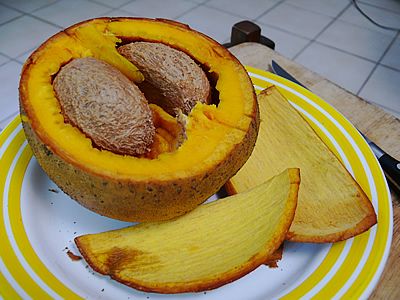The Mammea americana, better known as Mammee, is an evergreen, long-lived, and fruitful tree native to the Amazon region. This species stands out not only for its longevity but also for its ability to produce fruits for many years. In ideal growth conditions, such as in the rich and moist soils of the Amazon, Mammee can reach impressive heights, exceeding 20 meters (over 65 feet). Its trunk is short, providing a sturdy structure that supports the dense and leafy canopy, whose shape varies from pyramidal to oval. This canopy configuration gives the tree a highly ornamental appearance, comparable in size and shape to the Southern Magnolia (Magnolia grandiflora).
The leaves of Mammee are elliptical to obovate, displaying a leathery texture, which is typical of many trees in tropical regions. Their dark green color and the characteristic sheen of the opposite leaves add a special charm to the tree’s appearance. These leaf characteristics are indicative of the plant’s adaptation to humid environments, where water loss through evaporation needs to be efficiently controlled.
Flowering occurs in late spring and early summer, a period that coincides with increased humidity and temperature in its natural habitat. The flowers are large and white, often appearing solitary or in opposite pairs. The long stamens form a central tuft, a detail that captivates with its beauty. It is important to note that Mammee flowers are pollinated by a variety of insects, a crucial aspect for the species’ reproduction.

The fruits of Mammee are edible berries, although they are often mistakenly classified as drupes. Globose in shape, they have a brownish skin that encloses a fleshy, soft, and yellow to orange-colored pulp. Each fruit carries four seeds, and their sweet taste varies in texture, ranging from crispy to juicy, firmer, or softer.
Apart from its ornamental beauty, the Mammee tree is ideal for composing tropical groves, whether in isolated plantations or rows. Its dense and sturdy foliage serves as an efficient windbreak, protecting smaller and more delicate areas of the garden. Due to its substantial size, planting Mammee is more recommended for spacious gardens, parks, and farms, where there is enough room for its full development. An interesting aspect of Mammee is its slow growth, taking six to ten years from planting to the first flowering, a factor that should be considered in landscaping planning.
The fruits are versatile in cooking, as they can be consumed fresh or cooked, and they are used in syrups, preserves, and liqueurs. On the other hand, the peel and seeds are astringent and should be removed before consumption. From the flowers, a liqueur-like and aromatic distilled spirit known as Eau Créole is produced. The seeds also possess insecticidal and parasiticidal properties, traditionally used to control pests such as lice, ticks, fleas, and worms.

It should be grown in full sun or partial shade, in fertile, deep, well-draining soil enriched with organic matter and irrigated regularly, especially in the first years of establishment. It thrives in tropical heat and humidity, developing better in regions with annual rainfall rates above 1500 millimeters (59 inches).
In other locations, supplemental irrigation is recommended. Mammee does not tolerate intense cold, frost, or periods of drought. Regular organic fertilization, as well as a good mulch cover maintained on the soil, are important for Mammee. It can be propagated by seeds or preferably by grafting (a form of cutting). Seeds have slow and uneven germination, taking 60 to 260 days to complete.

